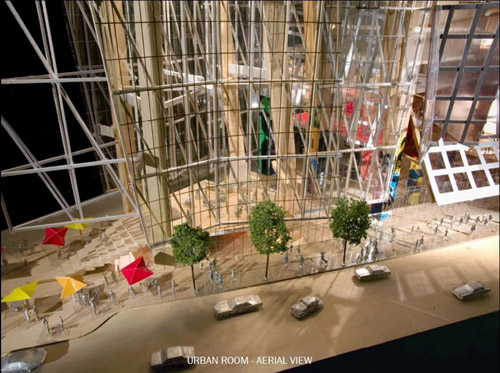Gowanus Lounge Double Speak of the Week: Publicly Accessible Open Space

Last week we had "friendly condemnations," this week our Double Speak of the Week is "publicly accessible open space." Whereas the "friendly condemnation" is an utterly reprehensible twist on the English language, "publicly accessible open space" is a more subtle affront because it is really more than double speak. It is an unfortunate indication of what has happened to our concept of open space after decades in which the private sector has been left to take the lead in creating amenities in the urban environment.
Back when government built parks with public money, we called them parks or open space. Now that government builds parks with private money or has developers build them, parks have morphed into "publicly accessible open space." It is not entirely unlike opening the door to your apartment or (if a Higher Power has blessed you so) your backyard or deck or balcony) to the general public and calling it "publicly accessible enclosed space."
In any case, Norman Oder, in his incomparable Atlantic Yards Report--the blog that offers the most accurate and detailed guide to Atlantic Yards of any print or online publication--offered insight this week into the "Urban Room" that could rise at Atlantic and Flatbush. Quothe Mr. Oder:
A significant part of the open space promised for the Atlantic Yards project would be a soaring, 120-foot, glass-walled Urban Room at the corner of Atlantic and Flatbush avenues. According to the General Project Plan released by the Empire State Development Corporation: An Urban Room connected to the Arena will serve as a significant public amenity by accommodating the major flows of people to and from the transit center during the day and night, serving as a direct subway entrance to the Arena and allowing for a variety of public uses and programmed events throughout the year.Perhaps calling a developer on plans to make "public open space" private once a month is nitpicking. Maybe not. The broader point is that in its old-fashioned form, public space was just that--space to be freely enjoyed by the public. Whereas "publicly accessible open space" is privately controlled space made available to the public either by the good graces of the private owner or by legal requirments imposed by the public sector that required the construction of this space as a condition of allowing the private development to go forward.
But the Urban Room would be "publicly accessible open space," not public space, and Forest City Ratner (FCR) plans to close the space once a month for private events. Similarly, even though seven landscaped acres planned for the eastern portion of the project has been billed by the developer as "publicly accessible open space that everyone can enjoy," new documents released show that FCR would reserve half of that open space for private events once a month.
It's not unusual for private events to be held in privately-managed open space; even public parks are used periodically for such events. Still, Forest City Ratner hasn't exactly disclosed its plans in its public statements. The promised Atlantic Yards open space would be "for the entire community of Brooklyn to enjoy," as the developer said in a flier two years ago.
Privately-controlled space is privately managed, uses private security and operates under rules set by the owner. It's not unlike a shopping mall. The user is free to do as one pleases (mostly shop) until one breaks the rules--say, handing out flyers, or walking around with a protest sign or wearing something that mall security deems offensive. Yes, public parks and real public spaces have rules too (we've recently taken the state parks in New York to task for their excessive rules), but they tend to be far less restrictive and somewhat less subject to whim, if only because bureaucracies are more cumbersome than a mercurial private landowner ordering security to harrass people wearing, say, "Ratner Sucks" or "Miss Brooklyn Bites" t-shirts. Of course, the other trend is turning over management of public spaces to private entities.
If you want a thorough discussion of why Forest City Ratner's "public space" won't be like Olmsted's public space, AYR's discussion is required reading.

0 Comments:
Post a Comment
<< Home